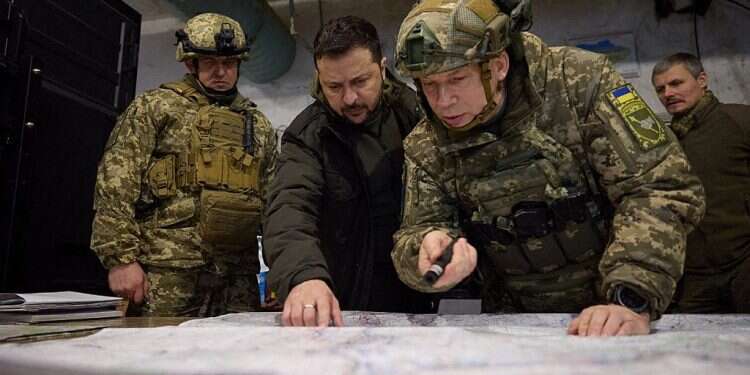Ukrainian forces withdrew from Avdiivka over the past weekend. This retreat from the decimated town in Donetsk captures the set of problems that Kyiv is facing as it enters the third year of the war.
The defenders suffered from a numerical disadvantage against the Russians, who did not spare cannon fodder; Ukraine's fighters also had to economize the dwindling ammunition; and for the first time since the start of the war, they could not prevent Russian planes from providing air cover for the attackers. Eventually, the Ukrainians withdrew from what was left of the town so that they could redeploy in new defensive positions. As of this week, the Russians are trying to break through defenses in two other sectors, though not very successfully.
"Ukraine's main goal this year will be to prevent the expansion of the occupation, and to inflict maximum casualties on the Russian army," Yury Fedorov, a Prague-based Russian military expert and the author of "The Ukrainian Front in World War III", told Israel Hayom. "It seems that Putin has ordered the completion of the conquest of the Donetsk Oblast. This will be an extremely difficult task, as they will need to take control of two well-fortified cities in the region. From Kyiv's perspective, the most rational strategy will be to defend the existing situation, while simultaneously stockpiling weapons and training forces for a counteroffensive in 2025."
Video: An unmanned sea drone / Ukrainian Armed Forces
However, none of these missions are self-evident for the Ukrainians, and there are at least three factors that could dramatically affect the coming year from Ukraine's perspective. The first is the issue of conscription. On paper, there are 11.1 million men eligible for conscription in the country – only a third of Russia's available manpower – with 11% of them already in uniform. Of the remaining men, 3 million live in occupied territories, about 1 million are abroad, and another 1.5 million have various disabilities.
In addition, the Ukrainian government faces an agonizing dilemma: Every able-bodied man conscripted means a loss of working hands for the economy, which has been struggling due to the burden of the war. Legislation that would change the criteria for exemption and bring additional groups into the conscription range has become a hot political issue in the country.
(Not) waiting for Uncle Sam
The second difficulty is the supply of weapons from Western allies. It's not just about artillery shells, but also air defense interceptors, which are already in short supply. The United States, the largest arms supplier, used up the special budget in December, and since then, Republican lawmakers have been blocking the aid package intended mostly for Ukraine ($60 billion) and Israel ($14 billion), even though in practice the funding would be mostly used in the United States for production purposes.
Meanwhile, European allies are still unable to fill America's shoes. "Europe will have to at least double its current military support efforts in case there is no further support from the United States. " Prof. Dr. Christoph Trebesch, who heads the International Finance and Macroeconomics research center at the Kiel Institute and runs its Ukraine Support Tracker, said earlier this month. "This is a challenge, but ultimately a question of political will. "
Follow Israel Hayom on Facebook, Twitter, and Instagram
Nevertheless, positive developments have taken place over the past two months: Britain, Germany, and France have committed to providing an additional €13 billion in military aid this year, and have signed bilateral agreements with Ukraine on defense and security cooperation; the Czech Republic has identified 800,000 shells in warehouses around the world and is seeking funding to purchase them for Kyiv; and Denmark is handing over its entire artillery disposition to Ukraine.
Waiting for the F-16s
What's more, by June, up to 48 F-16 fighter jets are expected to arrive in Ukraine – although Fedorov warns against harboring sky-high expectations. According to Fedorov, "to change the dynamics of the war, planes alone will not suffice; this would require a concurrent supply of air-to-air missiles, armored vehicles, anti-aircraft systems, and other weaponry."
The third factor is the pace of development of Ukraine's own defense industries. This past autumn, contracts were signed with arms manufacturers to set up production lines in Ukraine. Likewise, shell production was ramped up, and drone production is expected to reach one million this year – 100 times the amount produced in the first year of the war. A special corps is being set up to operate them. There is also the sea drone disposition. In this field – at least as of the beginning of the year – Ukraine has a clear advantage.
Ukraine enters the third year of war with a new commander-in-chief, Oleksandr Syrskyi, who also brought a new team with him. President Volodymyr Zelenskyy dismissed the previous commander, the highly decorated and popular General Valery Zaluzhny, who believed that the war had reached an impasse – a message that had run against what the president wanted to project. Syrskyi will have to prove that Zaluzhny was wrong – a no small feat as he faces the 470,000-strong Russian contingent in the occupied territories within Ukraine, according to the Royal United Services Institute (RUSI) in London.
On the other hand, there are doubts about just how capable the Russian forces are: "In the summer, they stopped the Ukrainian counteroffensive, but since October, when they went on the offensive, they have not conquered anything except Avdiivka," Fedorov recalls. "It's hard to imagine them making another effort to take Kyiv, for example, or Kharkiv. Putin's optimal scenario for the coming year is the conquest of the Donetsk Oblast. In the summer, they may try to break through toward Zaporizhzhia in the south, because there are no natural obstacles there."
According to Fedorov, the worst possible scenario for Ukraine would be "the loss of American support, which would force a deep retreat and a defense from within cities like Poltava, Kharkiv, and Zaporizhzhia."
The Israeli angle
The future of Ukraine in the third year of the war has an Israeli component as well – both because the joint aid package is stuck in Congress, and because the Gaza war has diverted attention away from there. "Biden was right: Israel is fighting against a terrorist organization, and Ukraine is fighting against a terrorist state," Yevgen Korniychuk, Ukraine's ambassador to Israel, tells Israel Hayom. "Therefore, we need to make a joint effort at the parliamentary level with the House of Representatives [to pass the aid package], and we are already working on that.
"Moreover, it is possible to use the vast experience of the Ukrainian army to strengthen Israel. The most advanced developments – drones, anti-drone systems, air defense systems – are being used in our theater of operations. There are ways to promote cooperation, for example, if Israel appoints a military attaché in Kyiv."
As the second year of the war in Ukraine draws to a close, it is increasingly clear that Jerusalem and Kyiv are knee-deep in a fight against the Tehran-Moscow axis. According to the ambassador, "There is no doubt that increased cooperation between Russia and Iran does not bode well for either Ukraine or for Israel."
Subscribe to Israel Hayom's daily newsletter and never miss our top stories!




